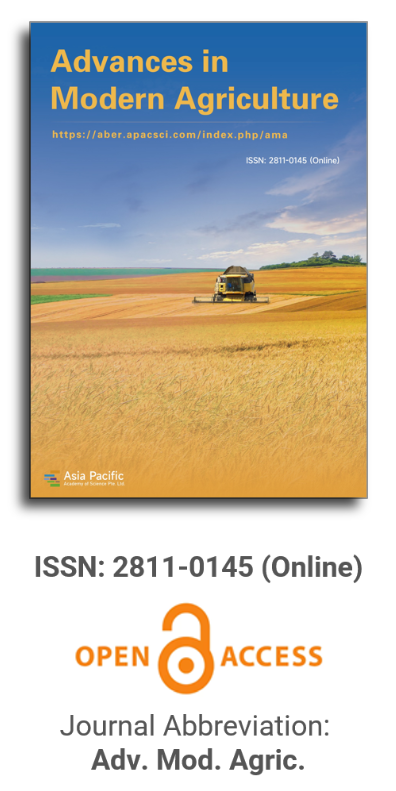


Defining and validating limits of meteorological parameters for high yield of wheat in Punjab, India
Vol 5, Issue 3, 2024
VIEWS - 2369 (Abstract)
Download PDF
Abstract
Wheat is a rabi season crop and is highly susceptible to abrupt increases/decreases in weather parameters. So, a study was conducted to compute the critical limits of temperature, relative humidity, and rainfall by analyzing meteorological and crop data (1999–00 to 2018–19) for six locations (Ballowal Saunkhari, Ludhiana, Patiala, Amritsar, Bathinda, and Faridkot) in Punjab. Amongst the 20 years, high, medium, and low yield years for each location were identified, and then meteorological data for crop growth stages, i.e., sowing-emergence (43–47 Standard Meteorological Week (SMW)), vegetative (48–02 SMW), anthesis (03–06 SMW), grain filling (07–11 SMW), and physiological maturity (12–15 SMW), were tabulated. The week-wise deviations of maximum/minimum temperature, maximum/minimum relative humidity, and rainfall from normal data of those 20 years under study were computed to derive their critical limits. Then these stage-wise critical limits were validated using the actual yields achieved during crop years 2019–20, 2020–21, and 2021–22. During a good crop year 2019–20, the upper and lower limits of the ranges accounted for high yields obtained at 03 locations and medium yields at the remaining 03 locations. During the crop year 2020–21, when the medium yield was obtained at all six locations, the major reason was the deviation of temperature above the upper range during the later grain-filling stage. On the other hand, during 2021–22, when low yield was reported at 03 locations and medium yield at remaining 03 locations, in addition to temperature deviations, heavy rainfall during SMW 1 and 2 (late vegetative stage) and hot and dry weather during SMW 10 and 11 (late grain development stage) were the major reasons. Hence it may be concluded that to get higher wheat productivity during vegetative growth, flowering, and grain filling, the maximum/minimum temperature ranges should be 16–22/4–9 ℃, 21–28/7–13 ℃ and 25–32/11–16 ℃, respectively; the maximum/minimum relative humidity ranges should be 85%–99%/39%–77%, 80%–92%/32%–66% and 75%–86%/31%–59%, respectively.
Keywords
References
- Indiastat. Area, Production and productivity of wheat in India. Available online: https://www.indiastat.com (accessed on 29 May 2023).
- Anon. Package of practices for crops of Punjab: rabi crops. Available online: https://www.pau.edu/content/ccil/pf/pp_rabi.pdf (accessed on 26 May 2023).
- Sandhu SS, Prabhjyot-Kaur, Gill KK, et al. Weekly temperature ranges for higher wheat productivity in central Punjab. J. Agrometeorol. 2018; 20: 23-30.
- Hakim MA, Hossain A, Silva JAT da, et al. Protein and Starch Content of 20 Wheat (Triticum aestivum L.) Genotypes Exposed to High Temperature Under Late Sowing Conditions. Journal of Scientific Research. 2012; 4(2): 477. doi: 10.3329/jsr.v4i2.8679
- Harrison PA, Porter JR, Downing TE. Scaling up the AFRC WHEAT 2 model to assess phenological development for wheat in Europe. Agricultural and Forest Meteorology. 2000; 101: 167-186. doi: 10.1016/S0168 -1923(99)00164-1
- Kaur P, Singh H, Rao VUM, et al. Agrometeorology of wheat in Punjab state of India. Research Gate. 2015. doi: 10.13140/RG.2.1.5105.6721
- Hundal SS, Kaur P. Climatic variability and its impact on cereal productivity in Indian Punjab. Current. Sci. 2007; 92(4): 506-512.
- Vijaya Kumar P, Rao VUM, Bhavani O, et al. Sensitive growth stages and temperature thresholds in wheat (Triticum aestivum L.) for index-based crop insurance in the Indo-Gangetic Plains of India. The Journal of Agricultural Science. 2015; 154(2): 321-333. doi: 10.1017/s0021859615000209
- Daloz AS, Rydsaa JH, Hodnebrog Ø, et al. Direct and indirect impacts of climate change on wheat yield in the Indo-Gangetic plain in India. Journal of Agriculture and Food Research. 2021; 4: 100132. doi: 10.1016/j.jafr.2021.100132
- Rao BB, Chowdary PS, Sandeep VM, et al. Spatial analysis of the sensitivity of wheat yields to temperature in India. Agricultural and Forest Meteorology. 2015; 200: 192-202. doi: 10.1016/j.agrformet.2014.09.023
- Kumar S, Patra AK, Singh D, et al. Long‐Term Chemical Fertilization Along with Farmyard Manure Enhances Resistance and Resilience of Soil Microbial Activity against Heat Stress. Journal of Agronomy and Crop Science. 2013; 200(2): 156-162. doi: 10.1111/jac.12050
- Singh H, Hundal SS, Kaur P. Effect of temperature and rainfall on wheat yield in south western region of Punjab. Journal of Agrometeorology. 2008; 10(1): 70-74. doi: 10.54386/jam.v10i1.1174
- Mahajan S, Kaur P, Sandhu SS. Weather-based thumb rule models for formulating the crop insurance schemes for wheat in Punjab. Advances in Modern Agriculture. 2024; 5(1): 2522. doi: 10.54517/ama.v5i1.25 22
- Ministry of Agriculture and Farmers Welfare. Effect of climate change on agriculture. Available online: https://pib.gov.in/PressReleasePage.aspx?PRID=1696468 (accessed on 13 May 2023).
- Lobell DB, Field CB. Global scale climate–crop yield relationships and the impacts of recent warming. Environmental Research Letters. 2007; 2(1): 014002. doi: 10.1088/1748-9326/2/1/014002
- Asseng S, Ewert F, Martre P, et al. Rising temperatures reduce global wheat production. Nature Climate Change. 2014; 5(2): 143-147. doi: 10.1038/nclimate2470
Supporting Agencies
Copyright (c) 2024 Prabhjyot-Kaur, S. S. Sandhu, Jagjeet Kaur, Agatambidi Bala Krishna
License URL: https://creativecommons.org/licenses/by/4.0/

This site is licensed under a Creative Commons Attribution 4.0 International License (CC BY 4.0).

Prof. Zhengjun Qiu
Zhejiang University, China

Cheng Sun
Academician of World Academy of Productivity Science; Executive Chairman, World Confederation of Productivity Science China Chapter, China
Indexing & Archiving
In the realm of modern agriculture, the integration of cutting-edge technologies is revolutionizing the way we approach sustainable farming practices. A recent study published in Advances in Modern Agriculture titled "Classification of cotton water stress using convolutional neural networks and UAV-based RGB imagery" has garnered significant attention for its innovative approach to precision irrigation management. Conducted by researchers from Institute of Data Science and the AgriLife Research and Extension Center of Texas A&M University (authors's information is below). This study introduces a novel method for classifying cotton water stress using unmanned aerial vehicles (UAVs) and convolutional neural networks (CNNs), offering a powerful solution for optimizing water use in agriculture.
Modern agricultural technology is evolving rapidly, with scientists collaborating with leading agricultural enterprises to develop intelligent management practices. These practices utilize advanced systems that provide tailored fertilization and treatment options for large-scale land management.
This journal values human initiative and intelligence, and the employment of AI technologies to write papers that replace the human mind is expressly prohibited. When there is a suspicious submission that uses AI tools to quickly piece together and generate research results, the editorial board of the journal will reject the article, and all journals under the publisher's umbrella will prohibit all authors from submitting their articles.
Readers and authors are asked to exercise caution and strictly adhere to the journal's policy regarding the usage of Artificial Intelligence Generated Content (AIGC) tools.
Asia Pacific Academy of Science Pte. Ltd. (APACSCI) specializes in international journal publishing. APACSCI adopts the open access publishing model and provides an important communication bridge for academic groups whose interest fields include engineering, technology, medicine, computer, mathematics, agriculture and forestry, and environment.



.jpg)
.jpg)

.jpg)
